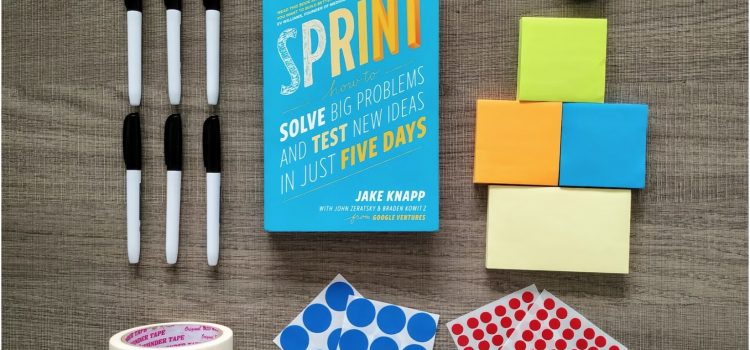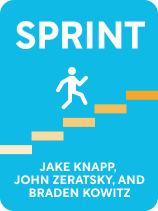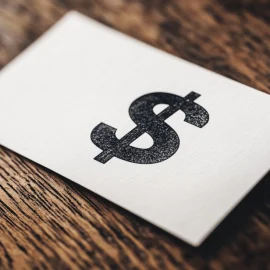

This article is an excerpt from the Shortform book guide to "Sprint" by Jake Knapp, John Zeratsky, and Braden Kowitz. Shortform has the world's best summaries and analyses of books you should be reading.
Like this article? Sign up for a free trial here.
Looking for an overview of Sprint? What is Jake Knapp’s Design Sprint process? What are the book’s key takeaways?
Jake Knapp developed the Design Sprint while working at Google Ventures, the investment arm of Google’s parent company. His process allows you and your team to build and test a prototype in just a five-day work week.
Keep reading for an overview of Jake Knapp’s book Sprint and the Design Sprint process.
Sprint by Jake Knapp: Book Overview
Do you have an idea for a product, but you’re not sure how to turn it into a testable prototype? Maybe you’re not even sure it’s worth pursuing at all. Well, using Jake Knapp’s Design Sprint process, you can build and test prototype products within a five-day work week, helping you determine your idea’s viability quickly and cheaply.
Jake Knapp invented the Design Sprint process while working for Google. After moving to Google Ventures (GV), he facilitated sprints with over a hundred companies, including Slack, Airbnb, and Spotify. Designers John Zeratsky and Braden Kowitz collaborated with Knapp at GV to refine the process, and Zeratsky and Knapp later co-authored a book on time management, Make Time. All three are experts in efficiency, productivity, and team improvement strategies.
(Shortform note: At its most basic level, a Design Sprint is a set amount of time in which a team works on a set of tasks to create a testable version of a product. Sprints gained their name due to their short duration and the high intensity of the work involved.)
In this article, we’ll show you what to do on each day of your sprint in a step-by-step format. In our commentary, we’ll teach you about the underlying principles behind the Design Sprint and provide examples of a sprint in practice.
(Shortform note: The authors organize their information about sprints into a day-by-day guide. This is arguably the most effective structure because each day’s tasks build on the day before, creating a smooth progression from planning your prototype, to building it, to testing it. Within each day, we’ve broken down the authors’ instructions into clearer steps and added new examples to more clearly illustrate the chronology of each day’s activities.)
| The Evolution of the Design Sprint: Its Roots in Design Thinking One source of inspiration Jake Knapp found for his Design Sprint process was IDEO’s design thinking workshops. The Design Sprint follows many of the same principles as design thinking: a process designers use to understand the needs of users, solve design problems, and develop products and services. Like the Design Sprint, design thinking is an iterative process. This involves creating many versions of the same idea and improving your idea using the information you gain from each iteration. Ultimately, design thinking can be broken down into two parts: identifying a problem and developing a solution. A design thinking process cycles through four phases, which repeat as many times as is necessary to create the best product. – First, there is the observation phase, when designers gather information about the customers who’ll use their product. – Second is the idea generation phase, when designers come up with as many solutions as they can to the problem they want to solve with their product. – Third is the prototype phase, when designers create sketches and models of the best ideas generated in the second phase. – Fourth is the testing phase, when designers have their target customers test the prototype product and give feedback. A sprint goes through one cycle of these phases: A series of multiple sprints, each testing different iterations of the same product, would look more like a typical design thinking process. Another distinction between design sprints and design thinking is that sprints follow a strict schedule, which is not always required for a design thinking cycle. |
Day 1: Planning the Sprint and the Customer Experience
Now that you’ve prepared for your Design Sprint, on Monday, Knapp, Zeratsky, and Kowitz suggest identifying a goal for your project and the questions you want your sprint to answer. You’ll also plan a customer’s experience with your product, from their first encounter with it through the full process of using it.
Identify Goals and Questions
The authors say to start off Monday by deciding on a goal with your team. It can be as broad and lofty as you want. When choosing your goal, think about the purpose of your project and what you hope it will achieve in the near and distant future. The information you learn from your sprint will help you progress toward this long-term aspiration.
For example, say there’s a team from a bookstore who are using their sprint to develop a prototype for a personalized book recommendation feature on their website. Their broader, long-term goal is to create a personalized online retail experience for their customers. Creating a successful recommendation tool would be one step toward reaching that goal.
(Shortform note: Other authors also advise starting the development process with clear goals for your product’s future. Marty Cagan (Inspired) calls this your “vision” in his product discovery process. To create a strong vision for your product, he suggests defining a clear “why”: You need to articulate why you think your product will be successful. Additionally, don’t be afraid to dream big. If your vision isn’t ambitious, it probably isn’t worth pursuing. Your vision should excite and inspire every member of your team.)
After you’ve identified your goal, the authors note, you must consider the challenges that could prevent you from achieving it. Identifying these now will help ensure that you’re not surprised by a new obstacle later on in the design process. On a whiteboard, rework these challenges into a short list of questions you want to be answered by the end of the sprint.
For example, one challenge of the bookstore’s recommendation tool could be its algorithm not picking up on the subtler qualities of books that make spontaneous, creative recommendations from a bookstore employee so special. The question related to this problem would then be, “Can an automated recommendation service provide the same quality of recommendations as a bookstore employee?”
Day 2: Creating a Design
On Monday, you narrowed down your priorities for the Design Sprint. Now you know where you’ll focus your attention during your sprint. On Tuesday, Knapp, Zeratsky, and Kowitz suggest you gather inspiration for your idea, create a drawing of your best design idea, and begin recruiting customers for Friday’s interviews.
Gather Inspiration
The authors argue that every good idea builds off of what came before, so you’ll start on Tuesday morning by gathering inspiration from other products and services. Every team member should make a list of products, either from your company or from another, that have features you can emulate in your own product. In short presentations, each person will explain the contents of their lists. As people present, record every product mentioned with a little sketch and blurb explaining what inspiration it has to offer.
(Shortform note: Drawing from other people’s products to create your design may feel strange. It may even feel like stealing. To get better as a designer, however, you have to study the products you admire to understand what makes them so successful. If you synthesize the successful elements you identify with your own ideas and experiences, you can create an original product with its own unique value. This doesn’t mean copying or even refashioning. It means adding your perspective to an existing conversation.)
Draw Your Ideas
Once you’ve reviewed your outside examples, it’s time to start drawing concrete designs for your product. Knapp, Zeratsky, and Kowitz outline a four-part process that each team member will complete individually on Tuesday afternoon. You will refine your ideas more with each part.
Day 3: Making Decisions
After spending Tuesday producing ideas for your Design Sprint, Jake Knapp instructs you to spend Wednesday deciding which one to pursue. Once your team leader selects the one you’ll use to inform your next steps, you’ll create a storyboard to plan for Thursday’s prototype.
Storyboard the Prototype
Once your team leader has selected a design, the authors instruct you to draw a more extensive storyboard of your prototype in use (10 to 15 panels on a whiteboard). Start by drawing the moment and the context in which the customer first engages with the product. For example, the first panel of the bookstore’s storyboard could show a web search for the bookstore’s website.
Fill in the other panels with steps that a customer will have to go through to use your product from start to finish. As the authors say, you’re telling the story of what you want to happen during Friday’s tests with customers. For example, the middle panels of the bookstore’s storyboard might include a drawing of each question prompt the customer will be asked before they receive their recommendations. They’d depict the layout of each screen, the important text involved, any images included, and so on. The last few panels might depict the various recommendations the customer received, showing what the profile for each recommended book would look like.
Day 4: Creating the Prototype
Wednesday was decision day—now, it’s time to use the storyboard you created to build your prototype.
Before you begin building, divide responsibilities for the creation of the prototype. Knapp, Zeratsky, and Kowitz recommend filling the following roles.
- One or two people make the individual components of the prototype. The authors suggest designers and engineers for this role.
- One person links the component parts into one cohesive product.
- One person writes any text necessary for the prototype.
- One person gathers any media (sounds, images, sample content, and so on) that can be borrowed for your prototype.
- One person writes the customer interview script on Thursday and conducts the interviews on Friday. In order to be as unbiased as possible during the interview process, Friday’s interviewer shouldn’t work on the prototype itself.
Day 5: Testing the Prototype
By Friday, you’ve reached the last day of your Design Sprint. According to Jake Knapp, you should next conduct one-on-one interviews with five customers and gain enough feedback to understand where to take your product next.
Set the Stage
According to the authors, you can identify the majority of problems with a product through just five customer interviews. This means they can all be done on the same day. You’ll start at 9:00 am on Friday, and each interview will be an hour long with a half-hour break in between. The person acting as the interviewer will be in one room with the customers and the prototype.
Put Your Product to the Test
Next, the interviewer should introduce the prototype and encourage the customer to begin using it. Knapp, Zeratsky, and Kowitz advise that you don’t tell the customer exactly how to use the prototype—leave them to figure it out for themselves. This will help you see if the product is naturally easy to use or if it has unexpected problems.
Review Your Results
The authors instruct you to silently review the notes on the whiteboard after the interviews, looking for patterns in the feedback. Did several customers comment positively on the same feature? Did several customers struggle during the same step? You can use these patterns to identify places that need improvement or features that worked particularly well.
Then, assess your findings by looking back at your sprint questions and your goal. Did you learn what you were hoping to? If not, what are your next steps? Even if your prototype was a success, the sprint probably still revealed flaws you need to address. Now you have the information you need to do that efficiently and effectively. If you still have questions you want to answer about your product after Friday, or you’re not sure where to take it next, you can always run another sprint. Whatever your results, no sprint is ever a waste of time.
| Decide Where to Take Your Product Next In The Lean Startup, Eric Ries discusses the outcomes that often arise after collecting customer data. Like Knapp, Zeratsky, and Kowitz, he offers two possibilities: You can carry out another iterative cycle to improve your product based on the weaknesses you identified, or you can decide to “pivot” away from your current direction entirely. If your product turns out to be too problematic to fix, Ries offers a few ways to move forward. First, you can alter your product so it focuses entirely on one feature the customers liked. Alternatively, you can choose to focus on a different need that the customer has, which will likely require you to design a new product. Finally, you can stick with the same customer problem but try to solve it with a different type of product. |

———End of Preview———
Like what you just read? Read the rest of the world's best book summary and analysis of Jake Knapp, John Zeratsky, and Braden Kowitz's "Sprint" at Shortform.
Here's what you'll find in our full Sprint summary:
- How to build and test a prototype in just a five-day work week
- The step-by-step processes for planning and completing a sprint
- How to conduct one-on-one interviews with your customers






